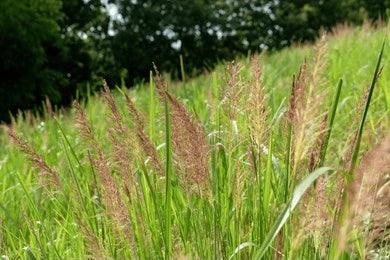Since it alleviates all heat-related health problems, ushira (vetiver) is known as nectar in the summer. Vetiveria zizanioides is the scientific name for the ushira plant. It is well-known by the name of Khus. These are referred to as perennial grass, and their large clumps can reach heights of one or two meters. Grass plant stems are called ushira tillers. Rhizomes give rise to the tillers or clumps. The clumps can reach a maximum height of eight feet. These tillers are strong and robust. Because of their modest size, the rhizomes never run out. These have very little lodging. The plants have robust, spongy roots. These have a distinct fragrant flavor. The plant has a very large, yet compact, well-organized, and robust root system. On both sides of the plant, it grows to a maximum depth of two feet, but it can reach up to eight feet. The plant's leaves can reach lengths of 120 to 125 cm and widths of 0.8 cm. The leaves have rough margins and are upright, flat, and thin. With whorl branches that are 2.5 to 5.0 cm long, the inflorescence panicles are 15 to 30 cm in length. These have a purple-brown hue. The spikelets have three stamens and are 1/8 to 1/4 inch long, with colors ranging from grey to purple.
General Description
Khus Khus grass is another name for Ushira that has made her renowned. The most well-known Ayurvedic herb for balancing the pitta dosha is this one. The Vedas make reference to it as well. It's been referred to as Gandhatrna. Both the Charak and Sushruta Samhitas make reference to it.
Vetiveria zizanioides is the scientific and botanical name for ushira. It is a member of the family Graminae. This tufted grass grows up to an elevation of 1200 meters in the Indian plains. It has antimicrobial, antibacterial, antifungal, diuretic, expectorant, digestive, anthelmintic, carminative, stomachic, antispasmodic, antiasthmatic, anti-oxidant, anti-arthritic activity, and anti-tigout qualities. Its roots are used to cure ulcers and have a cooling effect on the brain. Additionally, it is used to treat amenorrhea, dysmenorrhea, and anemia. The plant's oil has a calming effect on tension, stress, anxiety, and insomnia.
Phytochemicals such as calerene, gurjunene, aamorphene, benzoic acid, furfurol, vetivene, Khusimone, Calacorene, ß-humulene, a-longipinene, dselinene, d-cadinene, valencene, vetivenyl vetivenate, terpinen-4-ol, 5-epiprezizane, Khusimene, a-muurolene, epizizanal, 3-epizizanol, Khusimol, Isokhusimol, Valerenol, ß-vetivone, and a-vetivone are present in this plant oil and its other parts.
Classification
- Kingdom - Plantae
- Subkingdom - Tracheobionta
- Superdivision - Spermatophyta
- Division - Magnoliophyta
- Class - Liliopsida
- Subclass - Commelinidae
- Order - Cyperales
- Family - Graminae
- Genus - Vetiveria
- Species - Zizanioides
Habitat
Ushira is grown in Bangladesh, Malaysia, India, Pakistan, and Sri Lanka. Tropical regions of Asia, Africa, Australia, India, China, Brazil, Haiti, Indonesia, and Guatemala are home to its growth. Additionally, Indonesia, Malaysia, the Philippines, Jamaica, Japan, Angola, Belgium, Argentina, and British Guiana are among the places where it is produced. It grows in the Indian states of Madhya Pradesh, Kerala, Karnataka, Punjab, Uttar Pradesh, and Rajasthan. About 20–25 tons of oil are produced in India each year.
Names of the Ushira
- Sanskrit name - Virani, Veeratara, Valaka, Balaka, Ushira, Amrnala, Veerana
- English name - Kus Kus grass, Vetiver, Khas Khas grass
- Hindi name - Khus-Khus, Garara, Khas, Khas-Khas
- Bengali name - Khus-Khus, Venaghas, Khas, Khas-Khas
- Gujarati name - Valo
- Marathi name - Vala
- Telugu name - Vettiveellu, Vettiveerum, Kuruveeru
- Tamil name - Vattiver
- Kannada name - Kaddu, Karidappasajje Hullu, Vattiveeru, Laamancha
- Malayalam name - Ramaccham, Vettiveru
- Kannada name - Lavancha
- Fijian name - Mulimuli
- French name - Chiendent odorant, Vetiver
- Portuguese (Brazil) name - Patchuli-falso
- Spanish name - Zacate violeta, pacholi
- Tongan name - Ahisiaina
Ayurvedic Properties
|
Particular |
Hindi / Sanskrit |
English |
|
Rasa (Taste) |
Tikta, Madhura |
Bitter, Sweet |
|
Guna (Physical Property) |
Laghu, Rooksha |
Light, Dry |
|
Virya (Potency) |
Sheeta |
Cold |
|
Vipaka (Post-Digestive Taste) |
Katu |
Pungent |
Effects on Doshas
It balances vata and pitta doshas.
Classical Categorization
|
Charak Samhita |
Sushruta Samhita |
Vagbhata |
|
|
|
Practical uses
- It functions as a blood purifier, which helps to remove excess water from blood and protects the heart.
- The herb is useful in the treatment of diaphoresis and epistaxis.
- Ushira fortifies the stomach and aids in the regulation of gastric secretions and acid production.
- It is beneficial in treating digestive issues such as acidity, indigestion, and hunger.
- This plant is used to cure fever, diarrhea, and anorexia.
- It works well for respiratory conditions like cough, hiccups, and asthma.
- Ushira is a nerve relaxant that supports brain and nerve strength and calmness. Extremely beneficial for issues like brain abnormalities, vertigo, and unconsciousness.
- It works well for urinary problems and fevers brought on by high temperatures.
- The herb helps to improve the texture and radiance of the skin.
- It has antidotal properties and is beneficial in TB cases.
Parts Used
- Roots
- Vetiver oil
Dosage
- Powder - 3-6 grams
- Decoction - 50-100 ml
- Aqua-cold infusion - 50 ml

